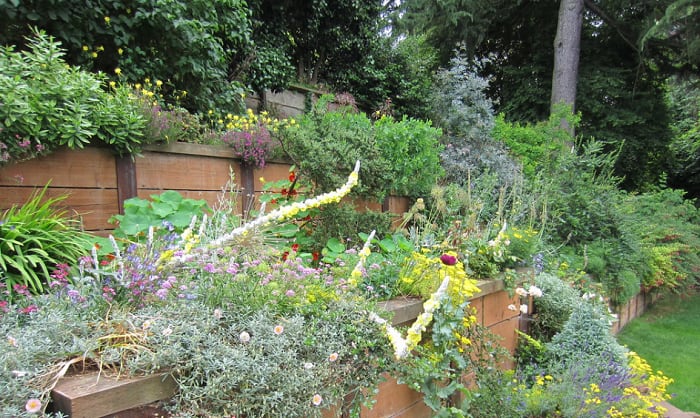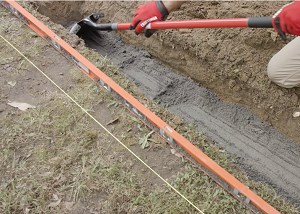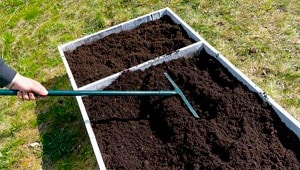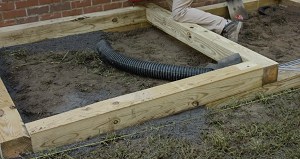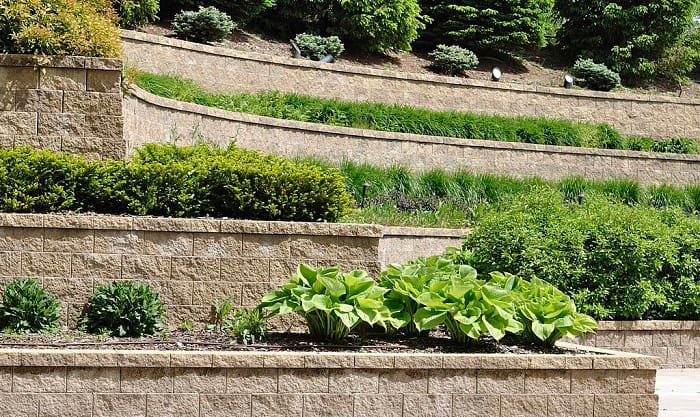If given a choice, everyone would want their gardens to have flat ground for easy plant watering and soil management. However, reality doesn’t always fulfill our wishes. That’s why it helps to know how to build a tiered garden on a slope.
Put simply, the task involves planning the size of your terraces, constructing the retaining wall, and filling the garden beds with soil. Read below for more details.
Table of Contents
What You Need
To create terraced garden beds on a slope, prepare the following:
- Two poles
- String
- Measuring tape
- Altimeter
- Chalk
- Pressure-treated timber – Have large pieces that you can cut to fit the dimensions of your garden bed
- Shovel
- Level
- Wood screws
- Drainpipe
- Drill
- Rebar and spikes
- Hammer
- Landscape fabric
- Store-bought soil (if the ground doesn’t already have enough of it)
Steps to Build Tiered Garden Bed on Slope
Step 1: Check your local building regulations
Digging into electrical cables and water pipes can be dangerous and illegal. Thus, before you terrace a sloped yard, check your home’s construction diagram for locations of utility lines and talk to the local government. Doing so will tell you whether you can start your building project.
In addition, authorities may have restrictions concerning walls and terraces. For example, if you’re building a retaining wall in Seattle, a permit is necessary if the wall is over 4 feet in height, in important areas like habitat conservation zones, and likely to damage nearby buildings.
Step 2: Determine the size of your garden tiers
The dimensions of your slope, specifically its rise and run, partly dictate the size and number of garden tiers you can build.
- First, find two poles and stick them into the ground of the slope (one at the lowest point of the slope, the other at the highest point).
- Second, get a string and tie its ends to your poles, making sure the string is taut and parallel to the ground. Then, measure the length of the string, which would be the run of the slope.
- Third, using an altimeter, note down the heights of the top and bottom of the slope. Then, subtract the lower number from the higher number to get the rise.
- Now, you can plan the size of your DIY terrace garden. For example, if your run is 30 feet and your rise is 10 feet, you can build five 6-feet-wide beds, with each bed having a 2-feet rise.
Step 3: Make a trench for your first garden bed
- Mark the outlines of your garden on a hillside according to the measurements you’ve determined above. You can use chalk for this.
- Then, make a trench at the bottom of the slope. The trench’s depth should equal ⅛ of the height of your retaining wall. Meanwhile, its width should be slightly bigger than that of your timber piece.
- The soil should be equally thick across the trench to reduce runoff and ensure your plants get the same amount of rainfall. To make sure this is the case, use a level to know whether to add or remove soil in certain parts of the trench.
- Afterward, put your wood block into the trench and recheck everything to make sure it’s level.
Step 4: Complete building the first garden bed
- Just like the previous steps, dig a trench for each of the remaining sides of your first garden bed. Then, put a wooden block in each of the new ditches. You should now have a plant box whose sides you can secure with screws.
- On one side of one timber block, make a square hole. This hole should fit a pipe that sends water from inside the garden bed to the outside.
- Then, on the wood blocks of the garden bed, drill some holes for the rebar. Hammer the rebar down the holes to reinforce the entire plant box.
- Next, prepare more wood blocks to line on top of the timber pieces you’ve already put in place. You should now have two layers of wood.
Note: That the joints of the second layer (the one on top) should not match the joints of the first one, but both layers should cover the same amount of area.
- Secure the two layers together with spikes. Make sure the first set of rebar and the new spikes don’t overlap.
Step 5: Install the drainpipe
- Put landscape fabric into the garden bed, on the same side as the drain hole you created.
- Then, lay the drain pipe on the fabric, pour gravel on the pipe, and fold the rest of the landscape fabric over the stone particles.
We recommend using professional-grade fabric that’s heavy, thick, and long enough to cover your pipe. For example, if the pipe is 5 feet in length, the fabric should be that long.
- Finally, fill the garden bed with soil, and you’re done with the first tier of your vegetable garden on a slope.
Step 6: Repeat the process for the next garden beds
Repeat step 3 to step 5 to construct your next garden bed. If you want your yard to have three tiers, do these steps three times.
That’s it! You’ve completed your project to build a terraced garden. Now, you can start planting.
Can I Terrace a Slope With Stone?
Yes. You can use stones to build a retaining wall if you don’t want to terrace a hillside with wood like we did above. Here are some tips for constructing stone retaining walls:
- Stone walls over 3 feet often require building permits.
- Reserve the biggest, flattest stones for the base.
- The trench should be 12-inch deep. Its width should equal half the wall’s height.
- Similar to the method above, the trench for the stone wall should also be level.
- Use gravel and coarse sand to line the inside of the trench.
- If you use more than two layers of stone, from the third layer, use deadman stones, so the wall is stable.
- It’s okay to use fieldstone, but flagstone and ashlar are easier to work with.
Is Building Raised Garden Beds on a Slope Possible?
Yes, tiered gardens on slopes can be made with or without raised beds. However, building raised beds on hills will be more difficult than doing so on flat ground. The reason is you’ll need to lift one side of the plant box up, so the entire structure stays level and drainage is not compromised.
Moreover, raised beds may require vertical support bars, which are an extra element to take care of. If you’re just building a regular tiered garden as we described above, you don’t have to construct these bars.
Read more: What is the cheapest way to fill raised beds?
Conclusion
We hope this article showed you how to build a tiered garden on a slope effectively. With a terrace ground, you can plant flowers like rock cress, candytuft, and sedums, or ground cover vegetation like big leaf periwinkle and ivy. There are many garden terracing ideas you can implement.
If you enjoyed this guide, please share it with other people. Thank you for reading!

Hi, I am William – Floridayards’ digital content creator. My job is to find answers to all your concerns with thorough research and our team’s expert advice. I will also bring you honest reviews on the best products and equipment for raising your beautiful garden. Please look forward to our work!


